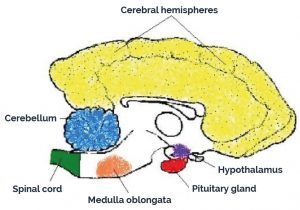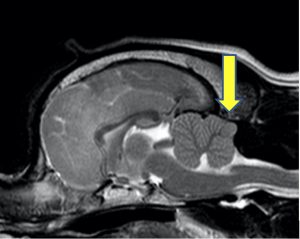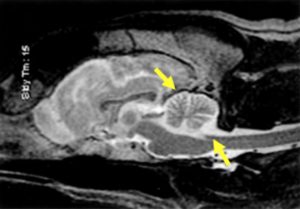Cerebellar Abiotrophy
in Dogs
Back to Fact Sheets
Cerebellum is a part of the brain at the back of the skull and just on top of the spinal cord. It is important in controlling muscle coordination.
Download PDF
What is cerebellar abiotrophy?
- Cerebellum: part of the brain at the back of the skull and just on top of the spinal cord. It is important in controlling muscle coordination.
- Abiotrophy: cells normally develop but prematurely degenerate.
- Cerebellar abiotrophy: after normal growth of the cerebellum there is then progressive degeneration of the cerebellum tissue, and the cells eventually die off. Also known as cerebellar cortical degeneration.
- Cerebellar hypoplasia: this is a different disease in which the cerebellum is small and underdeveloped because it didn’t grow to its normal size originally.

Why and when does cerebellar abiotrophy occur?
Some of the cerebellar abiotrophies have a genetic component and are therefore hereditary.
There are different stages of onset of the disease seen in different dog breeds:
- Neonatal onset – puppies soon after birth – breeds such as beagle, Coton due Tulear, Dachshunds, Irish Setter, Samoyed and Rhodesian Ridgeback
- Juvenile onset – 6w to 6m old – breeds such as Bernese Mountain dog, Airedale Terrier, Australian Kelpie, Bavarian Mountain Dog, Border Collie, Rough Coated Collie, Chinese crested, English bulldog, finish Harrier, Italian Hound, Kerry Blue Terrier, Labrador Retriever and Portuguese Podenco
- Adult onset – 1-8 years old – breeds such as Brittany Spaniel, American Staffordshire Terrier, Old English Sheepdog, Gordon setter, American Pitbull Terrier, Bernese Mountain Dog and Italian Spinone
What signs do dogs show with cerebellar abiotrophy?
The cerebellum is the part of the brain that controls the precision of the movements. It allows humans and animals to perform skilled activities. Therefore, in dogs with cerebellar abiotrophy, we will observe an animal that basically has exaggerated and uncoordinated movements of the whole body.
The presentation of the clinical signs might seem acute. However, the progression is slow and sometimes insidious. The early sign may be lack of coordination when negotiating stairs or turning around. Some owners describe difficulties swimming as the first clinical sign.
The landmark of this disease is the presence of what we call cerebellar ataxia. Ataxia means abnormal and uncoordinated movements. In this disease, these are accompanied by full body tremors (called intentional tremors) dysmetria and hypermetria (exaggerated movements). These dogs seem to have difficulties knowing where their limbs are, and the signs are more prominent when trying to perform slow movements.
How is cerebellar abiotrophy diagnosed?
Certain breeds have a genetic test available. A simple buccal swap or blood test could be useful for the diagnosis. In other breeds, the clinical signs, breed and age of the dog can be very suspicious. MRI imaging of the brain is a very useful tool. It will show a smaller cerebellum than normal with cerebrospinal fluid accumulating around the cerebellum. In milder cases a CSF analysis might be useful to rule out inflammatory diseases.

Normal canine brain MRI. Yellow arrow pointing to cerebellum

MRI image showing cerebellum appearing much smaller and with an increased amount of fluid around it
What treatment is required for cerebellar abiotrophy and what is the prognosis?
Unfortunately, at this date there is no treatment to stop or reverse the cerebellar degeneration so unfortunately the disease will continue to progress. The speed of progression varies within the breeds and is unpredictable. However, some dogs might life a long life with only mild clinical signs.
New measures in the house, like non-slip flooring, gates on stairs and swimming pools might be needed in these cases.


